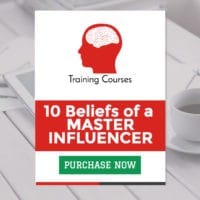11 Steps to Presentation Success!
 One of the most overlooked skills in both personal and professional development is the ability to present.
One of the most overlooked skills in both personal and professional development is the ability to present.
Last week I had two conversations, one with a lawyer and one with a business executive (who happened to have an MBA).
Here is how my conversations went… I asked both of them how long they went to school (to obtain the MBA and JD degrees).
Both said around 6 to 7 years. I asked them if they have to do presentations regularly for their clients and coworkers.
Both of them said yes.
The next question was, “How important is it for your career to be able to deliver powerful and influential presentations?” Both said, “Very important!”
Finally, “During those 6 or 7 years of schooling, how many presentation and public speaking classes have you taken?” Both responded, “One class!” Here is my point… Does it make sense to have several classes about presentation skills and influence if your career will depend on how well you communicate your message? Of course it does, but most universities have not caught on to that yet (good for me, because that is one of my specialties).
I have been teaching and coaching people to execute persuasive presentations for almost 7 years. I am the founder of the program called Influencing From the Front, the only program that combines sales, influence and presentation skills into one system. So let me give you some strategies on how to present your ideas, products or services in a more compelling and influential way. Remember, this is just a quick outline; I cover this entire process during a 3 day event. Here is the 11-step process to create a powerful presentation:
Step 1: Turn Your Psychology On: You must make sure you have the correct mindset when presenting. By mindset, I mean your primary beliefs about presenting (you believe you are a master presenter or you believe you are not a great speaker), your emotions before and during the presentation (do you have fear, doubt or uncertainty or are you fearless).
Step 2: Know Your Topic and Your Outcome: This step is simple. You must know at least 30 times more than what you are presenting, and you must be 100% clear on your presentation outcome. What do you really want to achieve? What do you want… more sales, more referrals, more branding, more commitment?
Step 3: Know Your Audience and Their Outcomes: The more you know about your audience (wants, needs, desires, habits, beliefs, values) the more influence power you will have. Also, you must know your audience’s buying criteria (what they really want; sometimes it is not what they tell you).
Step 4: Align the Outcomes: A master influencer delivers what his or her audience really wants (and sometimes more). You must create 3W scenarios (you Win, your client Wins, & society Wins).
Step 5: Brainstorming Ideas: For most people, the idea of brainstorming a presentation is to open a blank PowerPoint slide and start writing. That is a logical process, not a creative one. A creative process that I use is to write every single question that my audience or client would like to know on a piece of paper. That is a great way to brainstorm great content.
Step 6: Presentation Structures: This step is extremely important. This is how you organize your ideas. I teach more than 15 ways to organize your presentation. For example, one presentation structure that a lot of successful companies use is the Problem/Solution structure. They introduce the problem (pain) and then the solution (with features, benefits and buying criteria). Of course, the overall frame of your presentation must include an opening, body and a close. The body is the major part of your presentation, where you define the type of structure you are going to use.
Step 7: Create the Influence Framework: This step is the golden secret (most coaches do not teach this). Once you have your presentation structure complete (opening, body, close), it is time to make it influential. I use several influence and persuasion strategies like the use of pain and pleasure during my presentations. You demonstrate pain when the client realizes the danger, cost or consequence of not doing something. You demonstrate pleasure by showing how your product or service will help the client in a positive manner. You must be very careful when using pain. You must always have the client’s best interest in mind, no exceptions.
Step 8: Practice, Practice, Practice: Once your presentation is ready, I recommend you rehearse it at least 7 times out loud. You must feel comfortable with it.
Step 9: The Art of Deeply Connecting and Powerfully Delivering: You can give the same presentation for two executives, and yet have dramatically different results because one presenter was powerful, moving, funny and energetic, while the other was boring, monotone and put everybody to sleep. Humor is always a plus during your presentation (use it).
Step 10: The Art of Completion: When completing a presentation, you must be excited, caring and certain. Remember, certainty sells. You must also have a CTA (call to action), letting your clients know what the next step is.
Step 11: Learn From It, Drop It and Improve It! I heard someone say, “feedback is the breakfast of champions” and I agree 100%. After every presentation, ask yourself: a) what was great about it? & b) what can be even better next time? After you learn from your successes, let go of any part of your presentation that you did not like. Do not carry the past with you! Remember, every presentation is a chance to help someone, so give your best all the time. If a presentation is worth doing, it is worth doing extremely well!
To your success,
Roberto Monaco

